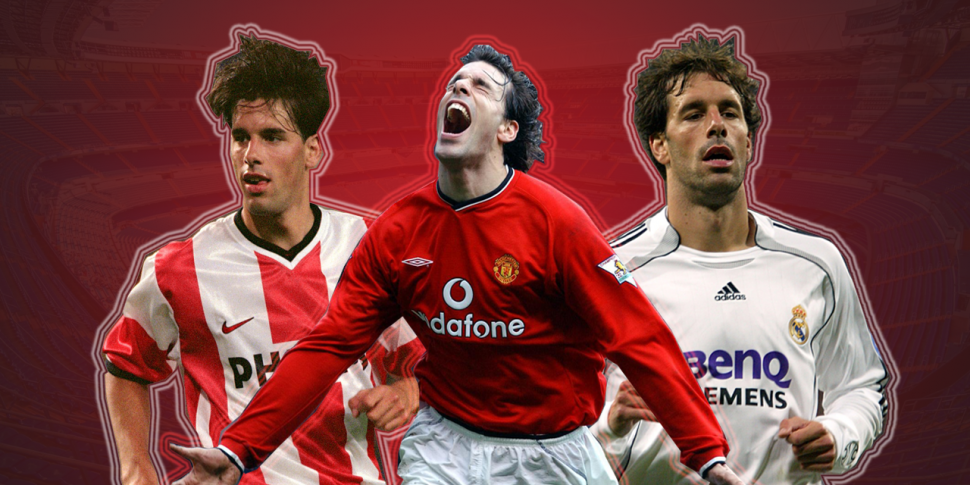Ruud van Nistelrooy had acquired the reputation of a monomaniacal goalscorer when he departed Manchester United in 2006. Speaking with teammates, opponents, coaches, the former President of Real Madrid and a few more, OTB's Arthur James O'Dea discovered the thoughts of those who look at the Dutch striker in a different light.
A little over one hour’s drive west from Ruud van Nistelrooy’s birthplace of Geffen stands an unusual bridge. Indeed, its peculiarity is drawn from the fact that it doesn’t stand at all. This bridge sits, largely submerged in the water it allows travellers to pass through. Invisible at a distance, one only grasps why it has become known as the ‘Moses bridge’ upon closer inspection.
A u-shaped wooden structure suspending the water on either side, its curious design reflected an historical sensitivity for the surroundings. Centuries earlier, this body of water was a protective moat. When a regeneration project sought to connect the land on either side, erecting a bridge over what had been a defensive structure seemed a touch ostentatious. Progress went quietly about its work instead.
Which leads to mixed thoughts about that biblical byname. Sure, Moses led the escaping Israelites through a split Red Sea with God’s assistance. That parallel is clear. As the Pharaoh and his army rallied in pursuit though, that ruthless Old Testament God went and un-parted the sea again, drowning the lot of them. The Egyptians had it coming, perhaps, but it would leave one wanting to be certain of your righteousness before crossing any ‘Moses bridge’.
Alex Ferguson has always considered himself to be firmly among the righteous. Like Moses, convenient pathways have disappeared after he passed through them. Like that unmerciful God, Ferguson also knows the value of dictating through his sacred texts how those pathways appeared in the first place.
It was largely through Ferguson's mythologizing that Ruud van Nistelrooy was portrayed as one in a series of wicked pharaohs. In reality, the Dutch striker provided just another bridge the Scot cut down behind him after navigating his own way across.
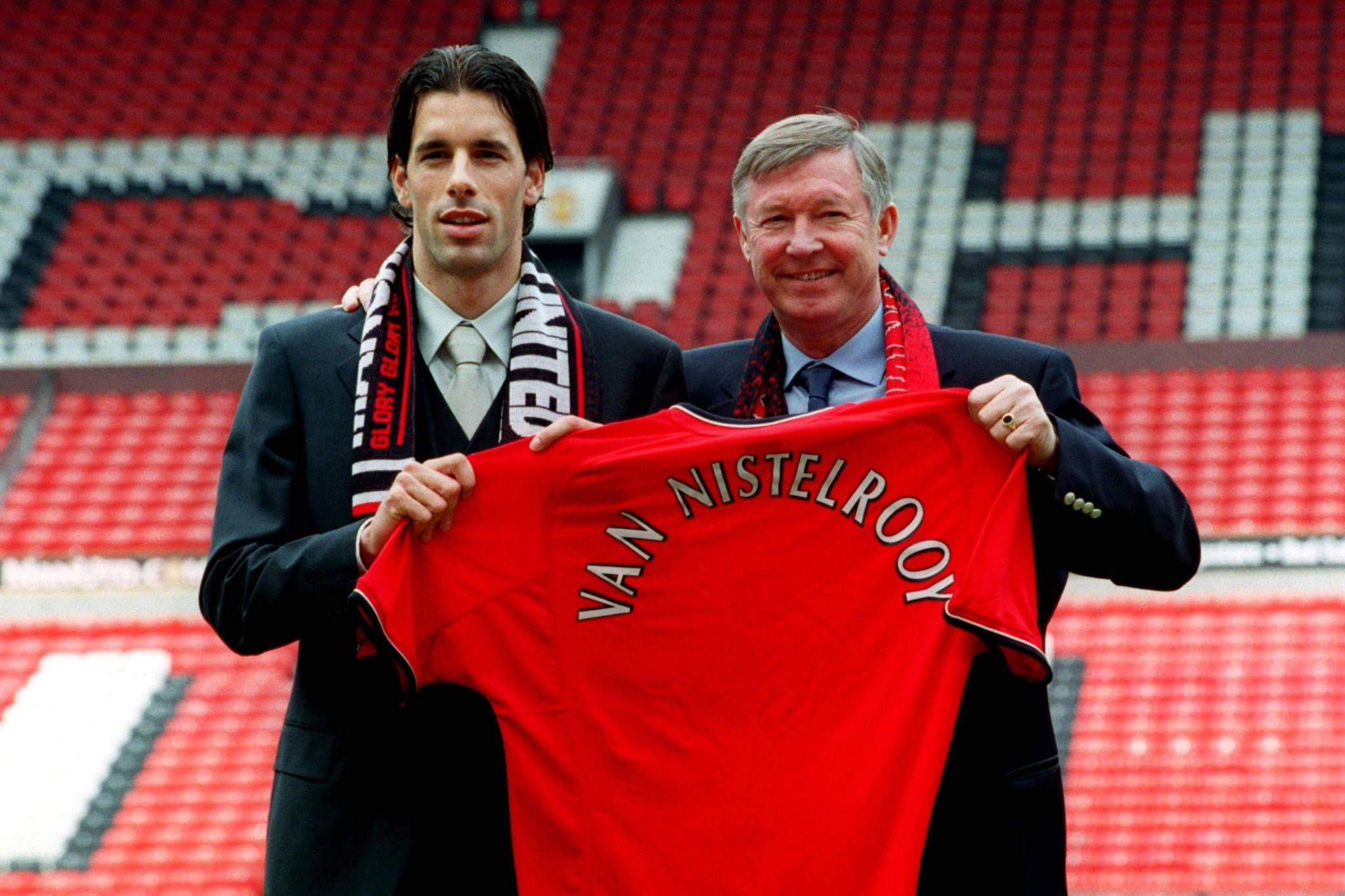 Manchester United manager Sir Alex Ferguson welcomes new signing Ruud van Nistelrooy to Old Trafford
Manchester United manager Sir Alex Ferguson welcomes new signing Ruud van Nistelrooy to Old Trafford*****
Arsène had a thing about Van Nistelrooy. I remember him saying he’d had a chance to sign Ruud but had decided he was not good enough to play for Arsenal. I agreed with him in the sense that Van Nistelrooy may not have been a great footballer. But he was a great goalscorer.
- Alex Ferguson, My Autobiography
In January 2010, Ruud van Nistelrooy reached out to Alex Ferguson. Three-and-a-half years after leaving Manchester United in acrimonious circumstances, he wanted to apologise. “Ruud offered no explanation,” recalled Ferguson of the conversation. “Perhaps it was a guilt complex. It might have been playing on his mind for ages. Ruud was doubtless a more mature person by that stage.”
Acting with impunity, Ferguson used van Nistelrooy’s confession as a springboard to explain why the Dutch footballer warranted a place uncomfortably close to the ‘savage tongued, beady eyed’ Roy Keane and the ‘slow learner’ Wayne Rooney in his latest book. Indeed, so busy was he detailing van Nistelrooy’s indiscretions, Ferguson never bothered to clarify whether he had accepted Ruud’s apology.
The Dutch striker was approaching the end of his time at Real Madrid. After two tremendous, league-winning seasons in Spain, the 33-year-old was no longer the great footballer he had in fact once been. “We signed him for two years,” explains Ramón Calderón to OTB Sports, the President of Real Madrid between 2006 and 2009. “I decided voluntarily to extend his contract by one more year because I thought he deserved it.”
A matter of weeks into his new role, Calderón had made the signing a priority. “United sold him and said he was injured,” he recalls, the £10 million or so required to complete the deal a curious bargain, “but when he came to us, he played almost all of our matches. I remember they said he was controversial, but Predrag Mijatović, my sporting director, he told me it was one of the best signings we could make. ‘Mr. President, with van Nistelrooy there is no doubt, no doubt.’ At the time they were all talking about some controversy between him and Ferguson and that he was injured, but I couldn’t see a better player in any sense.”
Deconstructing the grandiose Galactico model at Real Madrid, van Nistelrooy, Fabio Cannavaro and a repurposed David Beckham lended Calderón's plan purpose. “In sport, in life, talent alone isn’t enough,” he stresses, “and it wasn’t necessary to tell that to van Nistelrooy. He is one of those players you never forget.” The top goalscorer in title-winning seasons for PSV Eindhoven and Manchester United, Real’s dramatic 2006/07 triumph featured van Nistelrooy to the forefront once more.
“It was very important for us to win that title,” recalls Calderón, “because it was very difficult, and we had to come back from I think eight or nine points to beat Barcelona.” After an unimaginable three seasons without any success, van Nistelrooy’s arrival helped Real Madrid escape of the 'lost years' of Vanderlei Luxembergo, Antonio Núñez and Jonathan Woodgate. Although one of his final signings – Cristiano Ronaldo – reenergised Real’s Galactico leanings, the transcendent Portuguese who would spearhead the club throughout the 2010s benefited from Calderón's foundations.
“Having signed so many great players like Cannavaro, Pepe, Gonzalo Higuain, Marcelo, Arjen Robben, Ronaldo,” he says, “that Ruud van Nistelrooy was really one of my favourites is perhaps the best thing I can say about him. He helped to change the mindset and he is one of the best people and players I’ve known in my time in football.”
Real Madrid had crossed a bridge.
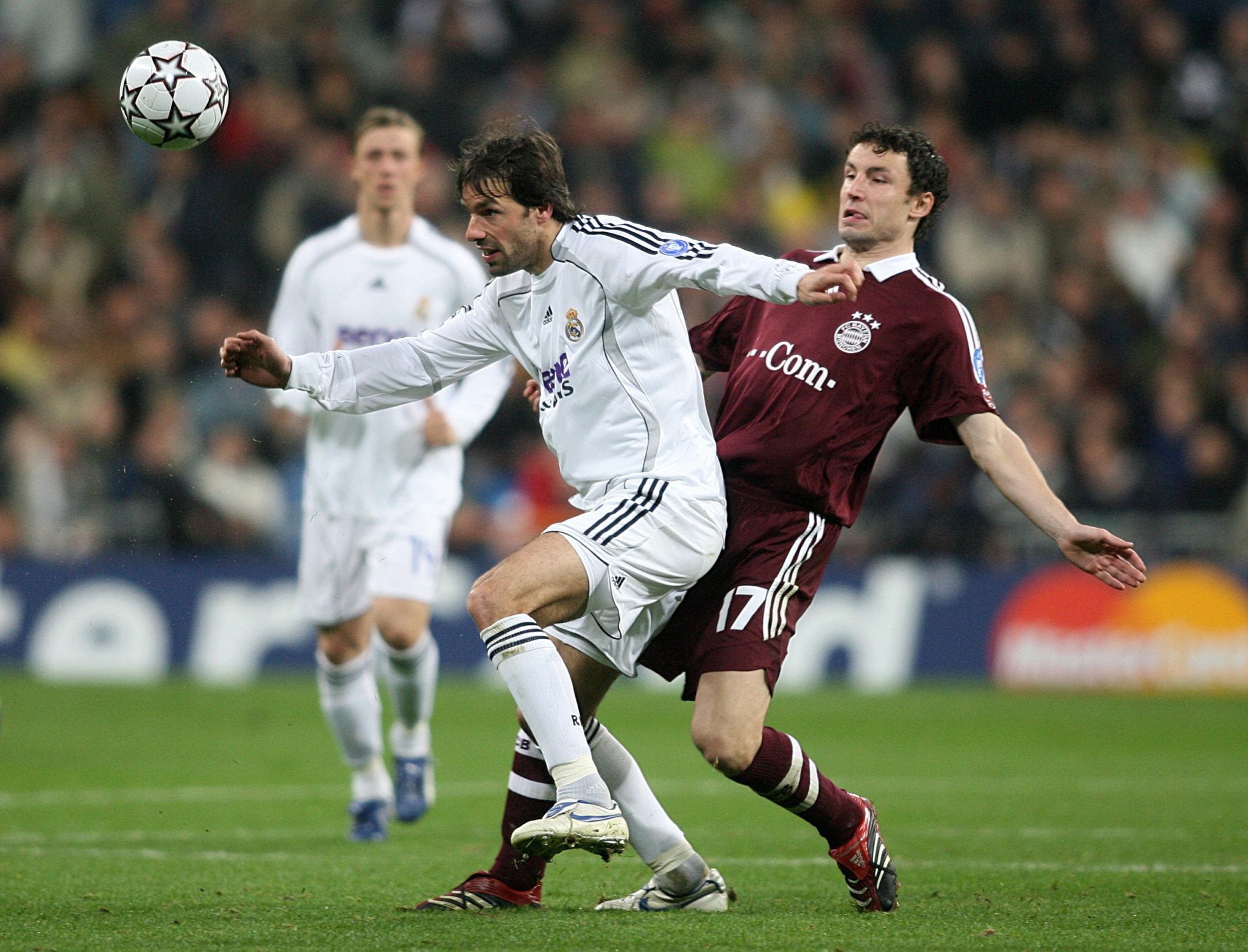 Real Madrid's Ruud van Nistelrooy and Bayern Munich's Mark van Bommel battle for the ball
Real Madrid's Ruud van Nistelrooy and Bayern Munich's Mark van Bommel battle for the ballHe had arrived at Manchester United as a 25-year-old ready to compete at the elite level. With the exception of Wayne Rooney (253), the enduring Ryan Giggs (168) and Paul Scholes (155), and the two-term Mark Hughes (163), van Nistelrooy would score more goals (150) for the club than any other player during the Ferguson era.
Unlike the above, van Nistelrooy would manage it all during a modest one-fifth of the Scot’s 26-year reign. He was prolific, a phenomenon and regularly overcompensating during a stagnant period for the club. Signed the summer after United cantered to a third successive Premier League title in 2001, for all his goals there would only be one more title won during van Nistelrooy’s five seasons. As United lagged, it was van Nistelrooy who often kept the heads around him above water.
Kenny Cunningham was a six-year veteran of the Premier League when he first encountered the Dutch striker with Birmingham City. He wasn’t immediately struck by his talents. “Technically, he wouldn’t have blown me away,” the former Republic of Ireland captain tells OTB Sports. “He was a good size then, don’t get me wrong, but in terms of speed he wasn’t too quick off the mark either. I mean, I would have been quite one-paced, but he wouldn’t have frightened me.”
While even the self-effacing Cunningham fancied himself on these terms, the product of van Nistelrooy’s genius became apparent in fleeting moments. “It is a cliché,” he admits, “but it all came down to his movement. His anticipation within the penalty box was as good as anything. What was exceptional about Ruud van Nistelrooy was his football intelligence. You could have put a blindfold on him, and he could have played in the box as effectively. He understood it that well.”
An impersonal opponent, there was never much sense of a one-on-one battle during Cunningham’s five games against him. While the Dubliner kept the prolific Dutchman to a modest two goals from play, he simply remembers van Nistelrooy going about his business in a ghostly manner.
“You would finish the game and think, ‘Yeah, I’ve done well there – I was in control,’” he explains, “but he’s poached a goal and won the game.” While Thierry Henry (“looks down his nose at you”), Dennis Bergkamp (“a nasty fucker, he’d hurt you”) or Robbie Fowler (“he could do anything, everything”) had all left one impression or another, van Nistelrooy was harder to pin down. “All the same, I liked how he carried himself,” he admits, “I would have liked to be in a dressing room with him.”
Matthew Lawrence doesn't share Cunningham's personal impression of van Nistelrooy. One half of Millwall’s centre-half pairing in the 2004 FA Cup final, van Nistelrooy scored twice in a 3-0 win for United that ended the London club’s remarkable run. Not that Lawrence is too hung up on it – they were Manchester United and he was Ruud van Nistelrooy, after all.
“Maybe I’m doing him a disservice,” he suggests 17 years later, reflecting on his one outing against the Dutchman, “but I always felt like he was only interested in himself and putting the ball in the goal. He almost struck me as an American, a baseball player interested in his own statistics above all else.”
Those suspicions are hardly unfounded. Gary Neville memorably wrote of his former teammate being visibly 'pissed off' if a game passed and he had not scored a goal. “He was cold and ruthless,” Lawrence goes on, the extent of which he experienced first-hand in the '04 Cup final. “From a corner kick where I was marking him, he just squared me up and volleyed me in the balls. Granted, before that I’d stood on his Achilles…”
Aloof at times, van Nistelrooy was well-grounded in problem-solving.
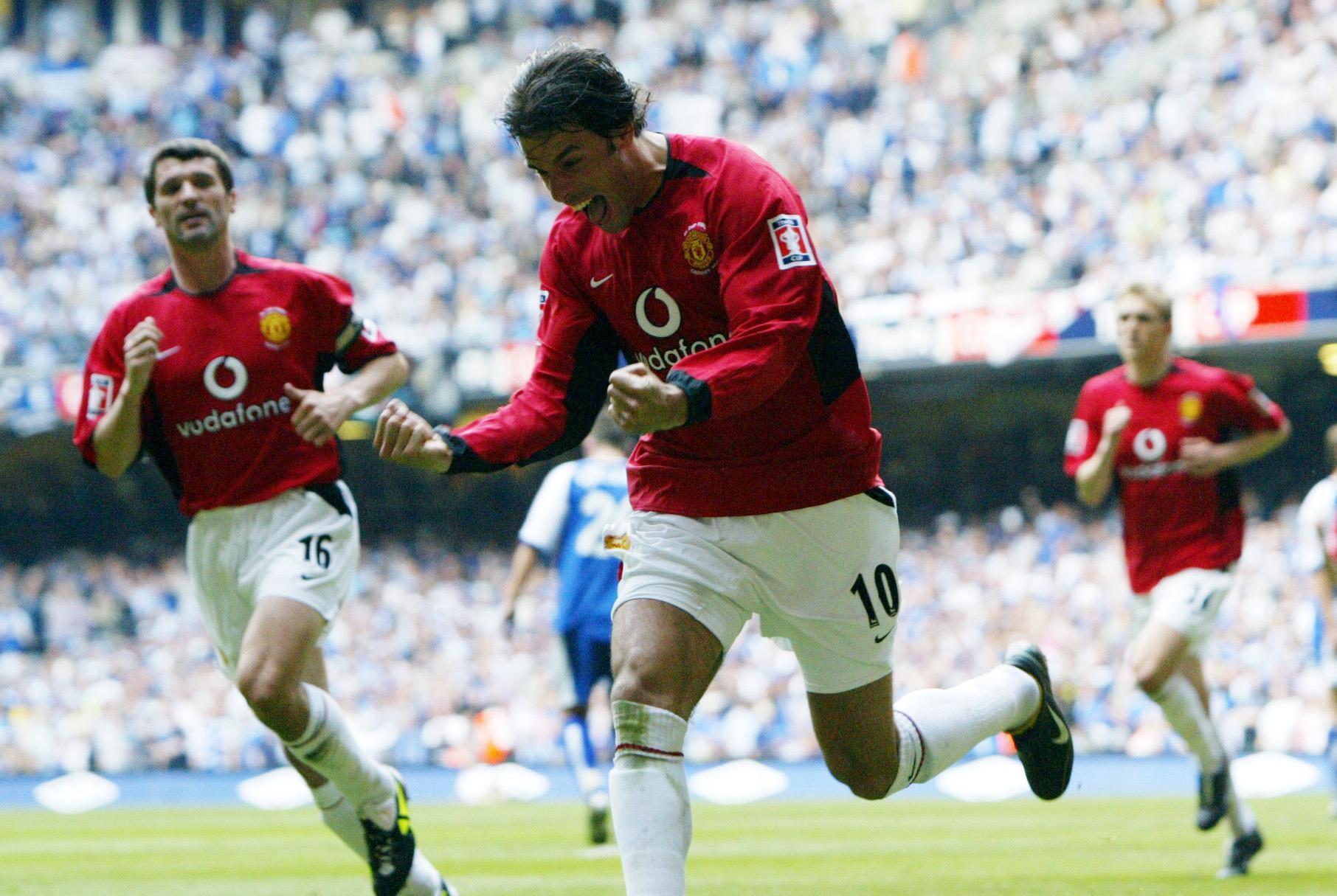 Ruud van Nistelrooy celebrates scoring his side's second goal against Millwall during the FA Cup Final
Ruud van Nistelrooy celebrates scoring his side's second goal against Millwall during the FA Cup FinalThe perception of van Nistelrooy as a limited footballer unjustly simplifies the extent of his extraordinary talent for scoring goals. Putting it down to a natural gift clouds the strange circumstances and doggedness of his ascent. The sixth most prolific goalscorer in Champions League history, he had not really played as a striker before meeting Foppe de Haan as a 20-year-old at Heerenveen.
“We saw him in training,” de Haan recounts to OTB Sports, “I told him, ‘Ruud, I think you’re more of a striker.’ Of course, he tells me, ‘No, no, no, coach, I’m a midfielder. I’ve always played #10, I like playing #10.” Signed from FC Den Bosch for an estimated fee just shy of €400,000, de Haan worked on van Nistelrooy’s reluctance. “I told him to go home and talk to his girlfriend, his Dad, his Mum,” he explains, “anyone he wants to talk to and tomorrow he will come and tell me if he wants to do what I want. He came back to me the next morning. ‘OK, coach, I will be the number 9, but you have to help me.’ That was a very ‘Ruud’ answer.”
Born on the same day in 1976 as Patrick Kluivert, that Dutch phenom had already travelled lightyears by 1996 - van Nistelrooy could scarcely have been termed his contemporary. “It was not easy,” recalls de Haan. “We had to talk a lot and I had to tell him how to behave, but he was working unbelievably hard. His drive was enormous and when he had a plan, he did it. ‘This is what I want’, he would tell me and each day, each day, each day until it is done, he will work.”
After scoring 20 goals across four years with Den Bosch, van Nistelrooy struck 16 in his single season with Heerenveen. In one sense, his manager trained him too well. “PSV Eindhoven didn’t want Ruud the year we bought him,” he remembers, “but after one season we sold him for €6.3 million. We missed him, yeah, but we were a small club and with that money it helped to build a new stadium. Everyone was happy.”
The substantial fee and van Nistelrooy’s subsequent success in Eindhoven made it all the more remarkable that his breakthrough had relied on the randomness of de Haan’s good eye. Raised far from the hot houses of Dutch football in Amsterdam, Rotterdam and Eindhoven, van Nistelrooy, like Boudewijn Zenden, Jaap Stam or Virgil van Dijk, travelled an alternative route.
“The Dutch south doesn't produce footballers, just cyclists” wrote Simon Kuper in The Guardian shortly after van Nistelrooy’s arrival in England. While he was slower getting off the ground, this circuitous course kept him in the air a little longer.
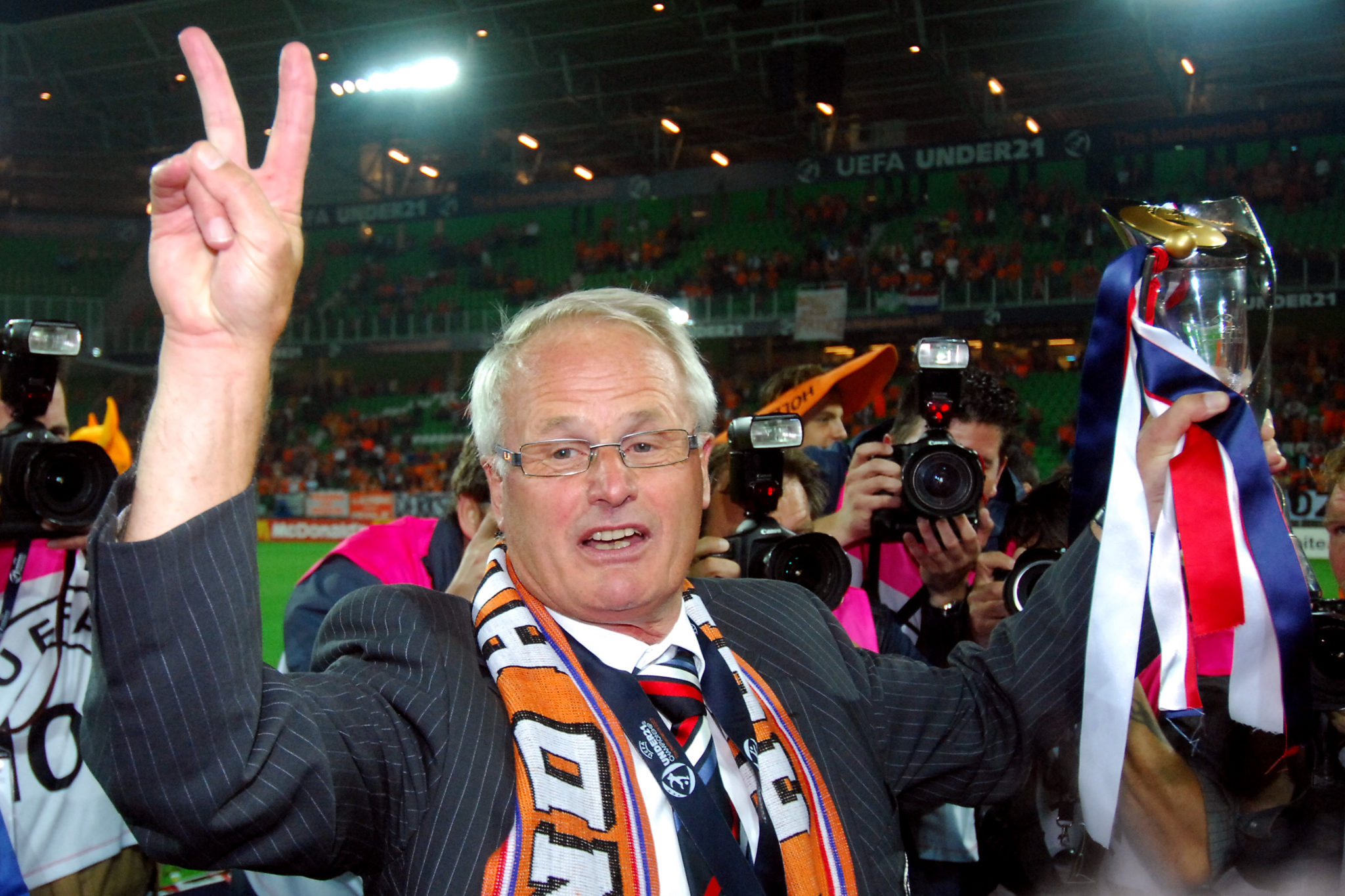 Holland's coach Foppe De Haan celebrates with the European Under 21 trophy, 2007
Holland's coach Foppe De Haan celebrates with the European Under 21 trophy, 2007“If I compare Patrick Kluivert who I played with at Ajax with Ruud who I played with at national level,” explains Martijn Reuser, “Ruud’s work ethic was higher than Patrick’s, and much higher than Ajax players in general. I look in the mirror too because when I went to England, I had to learn what hard work was.”
A product of the Amsterdam club’s famed academy, Reuser was winning Eredivisie titles with Kluivert, the de Boers and Marc Overmars for Louis van Gaal as van Nistelrooy watched Dennis Bergkamp videos to learn his new position. “He took a different road to the top from most Dutch players,” explains Reuser, “but he was fanatical about being the best. I was so impressed by his behaviour on and off the pitch, there was no doubt for me that he would succeed when he left for England.”
Five years after Kluivert had scored the winner in a Champions League final for Ajax, two breathtaking seasons in Eindhoven (73 goals in 78 games kind of breathtaking) convinced Ferguson to sign van Nistelrooy. After suffering an initial knee injury that appeared to jeopardise his place at the 2000 European Championships, however, a proposed £18.5 million deal never got over the line. When van Nistelrooy subsequently ruptured his anterior cruciate knee ligament in a training session that was horrifyingly captured on film, the transfer was kaput. Temporarily, anyway.
“I told him we would still be taking him to Old Trafford,” recalled Ferguson of a visit he paid to van Nistelrooy in 2001. “That was an important message for him because I don’t think he was the most confident lad at that point in his career. He was a country boy.” Dr. Cees-Rein van den Hoogenband would not have agreed.
“He was very determined and confident to come back,” PSV Eindhoven’s physician informs OTB Sports. “In his rehab phase he was very, very keen to pay attention to every detail.” Indeed, after a successful surgery with the famed Dr. Richard Steadman in Colorado, van Nistelrooy approached his recuperation much as he had approached becoming a striker at Heerenveen.
“Ruud said to me, ‘At the moment when I’m 100%, that’s when I’ll make my comeback. Nobody is going to force me, in PSV Eindhoven or the Dutch squad. I will determine when I am ready,’” van den Hoogenband explains. “I fully agreed with him and that’s why everything went so smoothly for him. He was very strong, very determined and that’s always been his character.”
It is a striking endorsement of the stellar work done during this period that the 25-year-old with a restructured knee had in excess of 400 games and his best days ahead of him. By 2006, the 30-year-old van Nistelrooy was setting off to Real Madrid as the hot-housed tulip Kluivert was leaving forgettable spells at Newcastle United and Valencia behind him to join, well, PSV.
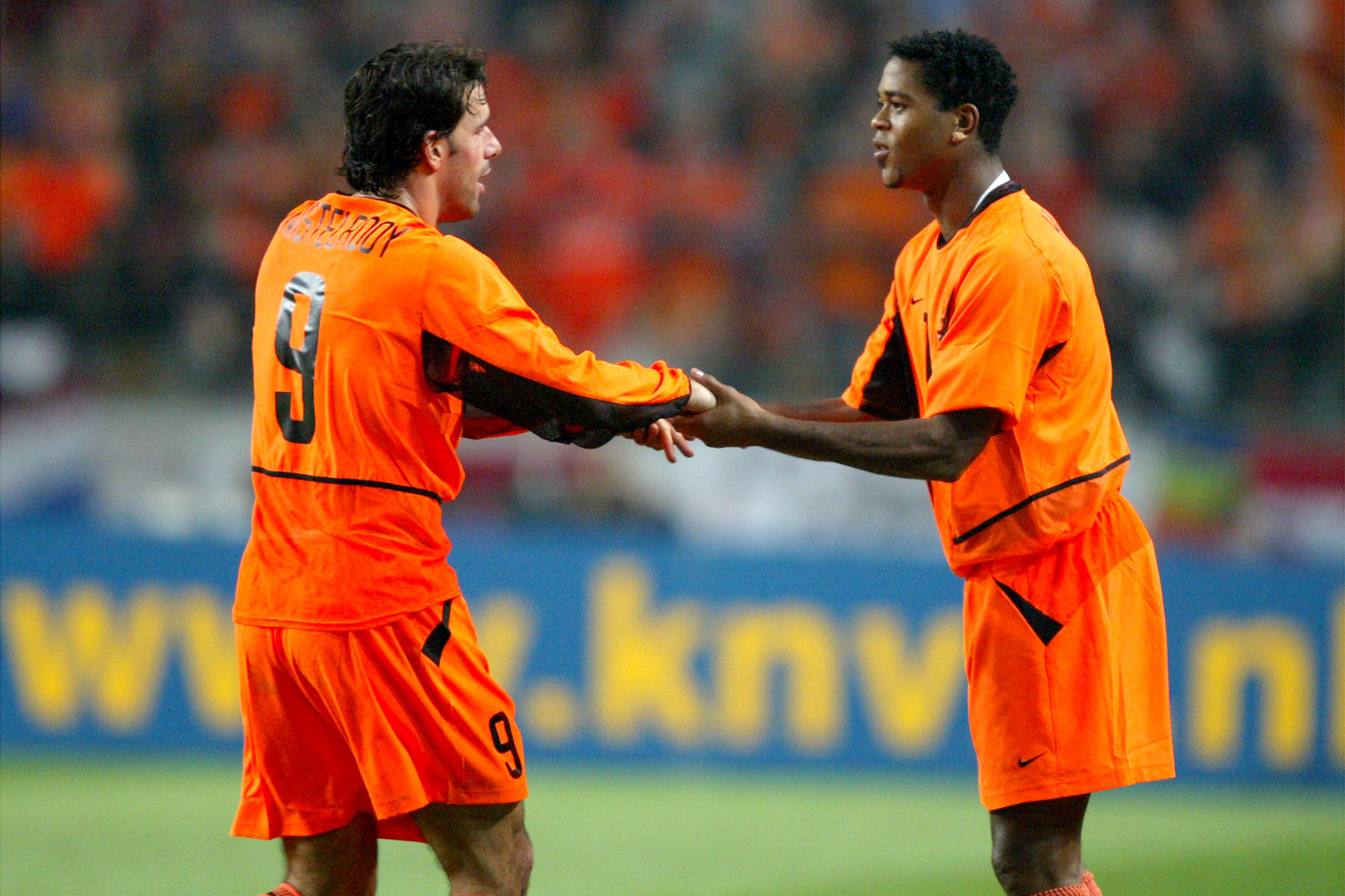 Holland's Patrick Kluivert comes on as substitute for Ruud van Nistelrooy
Holland's Patrick Kluivert comes on as substitute for Ruud van NistelrooyLike Julius Caesar crossing the Rubicon, Alex Ferguson has treated impediments to his divine progression uncaringly. Perhaps this unerring solipsism is a strength, but it is not always admirable, or believable. Dozing in what might have been the same living room where he took Ruud van Nistelrooy’s call in 2010, Ferguson, reflecting on his initial decision to retire from football at the end of the 2001/02 season, presents a quaint picture of how his extended tenure came about.
“The chief rebel came in and kicked my foot to wake me,” he told readers. “‘We’ve just had a meeting.’ Cathy (his wife) said. ‘We’ve decided. You’re not retiring.’ As I weighed this announcement I felt no urge to resist… That’ll teach me to nod off for five minutes. It ended with me working for 11 more years.” To his enormous credit, the Manchester United team of the second-half of 2006 through to 2011 that followed may well have been Ferguson’s finest. His decision to continue in the job was as wise as his planned retirement had been foolishly premature. Yet, by the summer of 2002, the realisation of this was still a few years away.
Rock of Gibraltar. Goalkeepers: van der Gouw, Bosnich, Culkin, Taibi, Rachubka, Barthez, Goram, Carroll, Ricardo, Howard. Beckham and the boot. Rio Ferdinand’s drug test. BBC Panorama: “Fergie And Son”. Kleberson. Eric Djemba-Djemba. “Pizzagate”. David Bellion. The Glazers. Dong Fangzhuo. Villarreal; Benfica; Lille; Manchester United.
Amongst all this, Ruud van Nistelrooy shone. His 25 goals pushed United on to win the one Premier League title they did secure while Arsenal became invincible, and Jose Mourinho weaponised Roman Abramovich's millions at Chelsea. Nevertheless, when Ferguson overcame the voluble claims that he was finished and began winning again, nothing of that bleak tenure was to be remembered fondly beyond his astute guidance of the club through it all.
Sure, van Nistelrooy scored all those goals, but wasn’t he perhaps a little too concerned with Ruud van Nistelrooy? “The only aspect he was ever interested in,” dictated the boss, “was how many goals did Ruud van Nistelrooy score.”
And yet, for many more who have worked with van Nistelrooy, this undeniable hunger for goals has never appeared more important than his willingness to work for them. “Ruud listens to people,” insists the PSV physician Dr. van den Hoogenband. “I’ll give you an example. He was always too fast when shooting at the goal. When he played together with Luc Nilis at PSV, Luc was excellent with his treatment of the ball. He took Ruud aside, gave him some instructions and typical Ruud, he listened. He had an open mind for ideas that’s not typically Dutch. Our attitude is usually a bit more selfish, that we know better. Ruud is not like that.”
The man who changed the course of van Nistelrooy’s career, Foppe de Haan has always been equally impressed by the striker’s openness of mind: “He could adapt and that was one of the most important things about him.”
An individual, nevertheless, the unfortunate timing of his move to Manchester United has had an unjustifiably negative impact on his contribution to the team that emerged after him. Although Wayne Rooney and Cristiano Ronaldo likely benefited from their experienced Dutch teammate’s eventual departure, his influence at the club was felt.
“When you see how hard Cristiano Ronaldo has worked, it is unbelievable,” Martijn Reuser points out, “but I don’t think it is a coincidence that he played with Ruud van Nistelrooy – he probably showed Ronaldo what it takes to be the best.” An outsider’s perspective, the Manchester United academy product Paul McShane tells a story that captures the essence of Reuser’s suggestion.
“I still tell this to young lads now,” the former Irish international explains to OTB Sports, 15 years after he departed the club in the same transfer window as van Nistelrooy. “When they were doing shooting sessions he was never ashamed or embarrassed of blasting the ball over the bar or wide. He would always be trying to hit the ball with pace into the corner, to be that accurate that now and again it was bound to go wrong. I’ve seen lads around training where they try to keep things safe just in case that happens. But as a top, top striker he was willing to make mistakes.”
Download the brand new OffTheBall App in the Play Store & App Store right now! We've got you covered!
Subscribe to OffTheBall's YouTube channel for more videos, like us on Facebook or follow us on Twitter for the latest sporting news and content.

